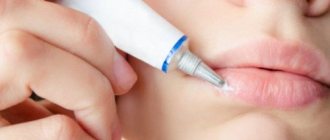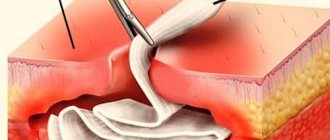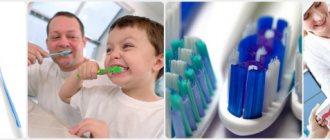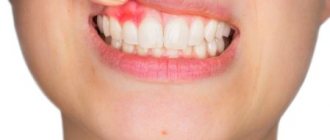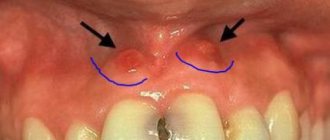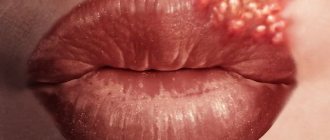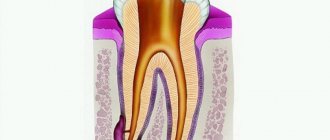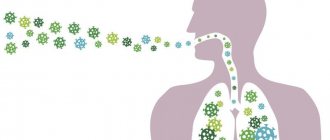The question of whether it is possible to go to the dentist with herpes worries those who suddenly have a toothache, but there are rashes on the lips. Herpes is a well-known viral disease that has a long history and is characterized by many forms.
The herpes virus is present in the body of 90% of the entire population of the planet. In some people it is dormant, while in others it constantly manifests itself, especially after provoking factors such as colds and decreased immunity. As a rule, people are especially worried about herpes on the lips, since it is impossible to hide it, and the white blisters attract a lot of attention, and the person feels awkward.
There are a number of cases when herpes on the lips can bring not only emotional discomfort, but also serious troubles. One such case is toothache due to herpes on the lips. Few people know what to do in such cases, because you want to stop the pain in your tooth, but you don’t want to go to the doctor with affected lips. Today we will talk about whether it is possible to go to the dentist with herpes if the toothache is very severe and you do not have the strength to endure it.
Why did herpes appear on the gums?
For the virus to make itself felt, two things are enough: its presence in the blood and a weakened immune system.
Infection occurs by airborne droplets and can be transmitted from mother to child. Unfortunately, once you become infected with herpes, you can no longer get rid of it. But you can prevent its activation.
So, after infection, virus particles settle in the body forever. Most of the time the virus does not manifest itself in any way. What factors provoke the manifestation of the virus on the gums? Stress, including sudden nervous shock, chronic depression and fatigue, colds, bacterial and viral diseases, hypothermia, autumn or spring hypovitaminosis. A common cause of the appearance of “bubbles” characteristic of this disease is acclimatization. Are you familiar with the situation when the disease manifests itself on vacation, when changing time zones? Therefore, when planning trips, it is better to immediately stock up on antiviral drugs and ointments.
Should you have dental treatment when you have a cold?
There is no definite answer to the question whether it is possible to treat teeth with a cold, because in some situations the pain can be so severe that it is simply impossible to endure it. Many dentists believe that it is not worth treating teeth if you have a cold, but each case is individual, and in each specific situation, a consultation with a specialist is first necessary, at which the doctor will determine whether it is better to postpone the visit or still carry out treatment. Dental treatment during a cold is not recommended for several reasons:
- A cold weakens the body's immune system, which increases the risk of contracting another infection.
- Certain types of dental procedures lead to the appearance of wounds through which infection can spread throughout the body.
From all of the above it follows that it is advisable to postpone dental treatment during a cold, even when the toothache is very severe. Moreover, a cold is most often accompanied by nasal congestion or cough, and you will need to stay in the dental chair with your mouth open for at least 40 minutes. This position during a cold can cause a lot of discomfort.
How to recognize herpes
The difficulty is that the symptoms of herpes in the mouth are easily confused with the manifestation of stomatitis and other diseases of the oral mucosa.
Differences:
- as a rule, stomatitis affects a larger area of the oral mucosa compared to herpes;
- swelling with herpes is less: with stomatitis, there may even be traces of teeth on the mucous membrane of the cheeks;
- ulcers that form during stomatitis have more defined boundaries;
- stomatitis often contributes to the appearance of a very dense coating on the tongue; with herpes, such a symptom does not appear;
- very often with stomatitis (especially purulent, with ulcers), the pain is more intense, it intensifies when the disease spreads over a large area of the mucous membrane. The pain is aching, especially in ulcers, and it becomes difficult to eat food, especially hard and hot food.
Photo of herpes on the gum:
If measures are not taken in time, a viral infection can become complicated and take the form of herpetic stomatitis:
How to understand that the virus has been activated? The first symptoms are tingling on the gums, itching and burning sensation. Then the color of the oral mucosa may change, unpleasant swelling appears locally, then a bright red rash appears, and the last stage is the formation of characteristic “bubbles” with liquid. As the disease progresses, the pain intensifies. When bubbles appear (they are called vesicles), the pain becomes cutting, its intensity increases when eating food or hot drinks.
Vesicles are dropsy filled with fluid with a high concentration of virus. Their sizes increase over time and can reach from 1 mm to 1 cm in diameter. At some point they burst, leaving a painful wound. If an infectious infection occurs, the wound becomes covered with a yellow crust, the mucous membrane of the oral cavity is increasingly affected, flowing into diffuse stomatitis.
External symptoms may include:
- increase in body temperature up to 38 degrees;
- chills;
- increase in size of lymph nodes;
- weakness, loss of strength;
- headache.
Such symptoms more often appear in children, with severe disease and the presence of an inflammatory process. In this case, you cannot do without consulting a doctor.
As a rule, the clinical picture of the disease is obvious. If a relapse does not occur for the first time, often the blisters are localized in the same areas: on the inner surface of the cheeks, tongue, gums. Your doctor may prescribe an oral swab to rule out a fungal or bacterial infection.
There are several types of herpes. As a rule, virus strains 1 and 2 appear on the gums. The consequences can be serious, especially if action is not taken promptly. If it was possible to extinguish the external manifestations of the infection, this is not a reason to refuse further treatment. First of all, you need to determine what type of herpes the patient is dealing with: PCR diagnostics will help with this. If you have a herpes infection, you can contact specialists such as an ENT specialist, an infectious disease specialist, or an immunologist. They will help you choose a treatment regimen that will minimize relapses of the disease in the future.
Should you visit the dentist if you have herpes?
A laconic description of the characteristics of herpes will help you form an idea of the possible consequences of treatment at the dentist. A qualified doctor will refuse to provide services to a patient and will begin treatment in exceptional cases. Herpes is a common chronic disease, the frequency of manifestation depends on lifestyle, characteristics of the body, and heredity.
Reasons for exacerbation:
- weakened immune system;
- colds, consequences of a viral disease;
- emotional exhaustion, tendency to depression;
- menstruation;
- abuse of strong drinks, smoking;
- poor nutrition, lack of vitamins;
- pregnancy;
- intoxication of the body;
- physical and emotional overload.
It is impossible to completely overcome the disease. The correct choice of treatment method will reduce the duration of inflammatory processes and reduce the frequency. It is practiced to use drugs for internal and external use; it is recommended to undergo an examination and consult a qualified specialist. If possible, you should discuss the possibility of visiting a dentist with a doctor who has selected a method for treating herpes.
It is impossible to remove a herpes infection from the body; everyone, even a healthy person, has the virus. In a dormant state, herpes is safe, does not cause inconvenience, and can appear often or only after serious illnesses. Herpes can appear the day before visiting the dentist; a peculiar protective function of the body, fear of upcoming procedures stimulates inflammatory processes. If herpes appears within a few days, ideally you should reschedule your visit to the dentist. For a quick recovery, it is recommended to discuss the causes of exacerbation of the disease with a doctor and select effective means that stimulate recovery processes.
Antiviral drugs
Their goal is to suppress the pathogen, shorten the duration of the exacerbation, and reduce the intensity of symptoms. The most popular products are Acyclovir and Zovirax in the form of tablets and creams. Using cream in the mouth is difficult, so tablets are optimal. They drink them in a course.
It is better to start treatment at the first signs of the disease. In some cases it can be stopped. Interferon nasal drops have also shown their effectiveness in the initial stages of herpes. At the very least, they prevent the spread of infection into the respiratory tract.
We have already found out that the main reason for the manifestation of herpes is weakened immunity. Conclusion: to avoid relapses, it is necessary to increase the body's defenses. To do this, you should contact an immunologist, who will refer you for diagnostics and prescribe individual treatment. Sometimes it includes immunomodulators - drugs that can increase immunity (Immunal, Imudon and others), folk remedies (for example, echinacea tincture), vitamin and mineral complexes. You can also take specialized complexes of vitamins and minerals, for example, ASEPTA® Parodontal to strengthen teeth and gums: its active components help not only reduce bleeding and inflammation in the oral cavity, but also maintain general immunity.
General recommendations on how to strengthen the body and increase its protection:
- avoid stress, improve sleep;
- include as many fresh vegetables, fruits, and herbs in your diet as possible;
- to drink a lot of water;
- exercise or swimming.
In case of exacerbation of herpes on the gums, it is recommended to adhere to a diet: remove spicy, fatty, too hot foods from the diet, exclude hot and alcoholic drinks. To avoid irritating the mucous membranes, avoid smoking.
The difficulty of using creams and ointments is not a reason to refuse local treatment for herpes. Rinsing and irrigating the oral mucosa will help relieve symptoms and prevent the spread of infection. Good products: Hexoral, chlorhexidine, hydrogen peroxide solution, furatsilin, as well as anesthetic sprays, rinsing solutions, gels with anesthetics (for example, Lidoxor gel, which relieves burning and irritation). Adhesive gum balm ASEPTA® is an effective combined antimicrobial agent that has a wide spectrum of action against gum disease pathogens, thanks to the combination of metronidazole + chlorhexidine, and guarantees long-term fixation on the gums.
Laser against herpes simplex symptoms
The Dial-Dent clinic offers a modern method of treating the symptoms of herpes simplex using laser radiation. For this purpose, a Picasso diode laser from AMD Lazers (USA) is used. The use of a laser allows you to minimize and completely relieve the symptoms of herpes on the lips in 2-4 days.
Laser irradiation destroys viruses, using a tissue-safe wavelength of 810 nm. Please note that not all dental lasers can be used in this wavelength range. Laser radiation with a wavelength of 810 nm kills viruses and bacteria without damaging body tissue. The same effect is used in periodontal treatment and sterilization of dental canals.
The laser is effective at all stages of herpes development:
- at the first stage, laser radiation helps relieve pain and reduce the intensity of rashes;
- at the second stage, laser radiation allows you to stop the further development of rashes, which leads to healing;
- at the third stage, the laser relieves pain and reduces inflammation;
- at the fourth stage, laser exposure leads to faster tissue healing.
Treatment of manifestations of herpes on the lips does not cancel treatment with antiviral drugs. If a cold on the lips is a frequently recurring condition for you, then the specialists of the Dial-Dent clinic will refer you for examination to specialized herpetic centers for an accurate diagnosis. Laser treatment of herpes can be used as part of the complex treatment of this disease.
The cost of one laser treatment procedure for herpes is 1,500 rubles. In some cases, especially in the early stages of the rash, one procedure is sufficient; in more severe situations, several procedures may be necessary.
Experts' opinion
Research conducted at the Kazan State Academy has determined that the use of preparations from the Asepta line (gels, balms, toothpastes, rinses) increases the effectiveness of treatment of chronic catarrhal gingivitis and other inflammations, mild and moderate chronic periodontitis, hyperesthesia of hard dental tissues, which together significantly reduces the duration of treatment and increases the duration of remission in this category of patients.
Sources:
- The use of drugs from the Asepta line in the complex treatment of inflammatory periodontal diseases (N.V. Berezina E.N. Silantyeva S.M. Krivonos, Kazan State Medical Academy. Kazan.) N.V. BEREZINA, E.N. SILANTIEVA, S.M. KRIVONOS Kazan State Medical Academy
- https://cyberleninka.ru/article/n/sovremennye-lechebno-profilakticheskie-sredstva-dlya-individualnoy-gigieny-polosti-rta Silantieva E.N., Berezina N.V., Krivonos S.M. Complex treatment of chronic recurrent aphthous stomatitis using drugs from the Asept line, Practical Medicine journal
- Clinical and laboratory assessment of the influence of domestic therapeutic and prophylactic toothpaste based on plant extracts on the condition of the oral cavity in patients with simple marginal gingivitis. Doctor of Medical Sciences, Professor Elovikova T.M.1, Candidate of Chemical Sciences, Associate Professor Ermishina E.Yu. 2, Doctor of Technical Sciences Associate Professor Belokonova N.A. 2 Department of Therapeutic Dentistry USMU1, Department of General Chemistry USMU2
- Clinical studies of antisensitive toothpaste “Asepta Sensitive” (A.A. Leontyev, O.V. Kalinina, S.B. Ulitovsky) A.A. LEONTIEV, dentist O.V. KALININA, dentist S.B. ULITOVSKY, Doctor of Medical Sciences, Prof. Department of Therapeutic Dentistry, St. Petersburg State Medical University named after. acad. I.P. Pavlova
- The role of anti-inflammatory rinse in the treatment of periodontal diseases (L.Yu. Orekhova, A.A. Leontyev, S.B. Ulitovsky) L.Yu. OREKHOVA, Doctor of Medical Sciences, Prof., Head of Department; A.A. LEONTIEV, dentist; S.B. ULITOVSKY, Doctor of Medical Sciences, Prof. Department of Therapeutic Dentistry of St. Petersburg State Medical University named after. acad. I. P. Pavlova
- Report on clinical trials of anti-inflammatory balm for gums "Asepta" adhesive, St. Petersburg State Medical University, 2007
A case of professional infection of a dentist. Herpetic whitlow
N. V. Bulkina
Doctor of Medicine, Professor, Head of the Department of Therapeutic Dentistry, Saratov State Medical University named after. V. I. Razumovsky" of Roszdrav
V. V. Masumova
Ph.D., assistant at the Department of Therapeutic Dentistry, Saratov State Medical University named after. V. I. Razumovsky" of Roszdrav
E. N. Polosukhina
Ph.D., assistant at the Department of Therapeutic Dentistry, Saratov State Medical University named after. V. I. Razumovsky" of Roszdrav
E. A. Savina
Resident Doctor of the Department of Therapeutic Dentistry of the State Educational Institution of Higher Professional Education “Saratov State Medical University named after. V. I. Razumovsky" of Roszdrav
D. V. Koblova
Resident Doctor of the Department of Therapeutic Dentistry of the State Educational Institution of Higher Professional Education “Saratov State Medical University named after. V. I. Razumovsky" of Roszdrav
Herpes infection is one of the most common and poorly controlled viral infections in humans and represents a serious medical and social problem. In Russia, various forms of herpes infection on the skin and mucous membranes annually affect more than 20 million people. Seroepidemiological studies conducted over the past 12 years have shown that by the age of 15, about 83% of the population is infected with the herpes simplex virus (HSV), and at the age of 30 years and older, more than 90% of the population has antibodies to HSV.
According to WHO, diseases caused by HSV rank second (15.8%) after influenza (35.8%) as a cause of death.
The causative agent of the disease is the herpes simplex virus.
HSV reproduction begins with its attachment to the epithelial cell of the oral mucosa and upper respiratory tract. The pathogen then enters the cell. In the cytoplasm, the virus nucleic acid is released from its protein shell. Next, the virus penetrates the cell nucleus, where viral DNA synthesis begins. The release of viral particles from the cell occurs between the 15th and 18th hours from the beginning of its reproduction cycle. The affected epithelial cell becomes a giant multinucleated one (ballooning degeneration of the upper layers of the epithelium in the area of skin and mucous membranes affected by the virus), which is clinically manifested by the formation of intraepithelial vesicles in the epithelial cells on the oral mucosa in the development of acute herpetic stomatitis.
Some virions, after leaving the cell, attach to nerve receptors and penetrate the nerve cell bodies of the sympathetic ganglia of the Gasserian ganglion along the axons of the nerves. Here the virus does not replicate, but goes into an inactive state, remaining in the cytoplasm in the form of an episome for many years. Reactivation of the virus, the causes of which are still unclear, leads to the development of recurrent herpes infection. Presumably, a relapse of the disease may occur due to a decrease in the body’s defenses.
The source of HSV infection is sick people and virus carriers. HSV is transmitted only from person to person by contact (direct contact, household contact), by airborne droplets and through damaged skin.
Due to the pronounced clinical polymorphism of acute and recurrent herpes viral diseases, patients can turn to doctors of various specialties, as a result of which in clinical practice the diagnosis of herpes viral disease is often of a topical nature, the etiology of the disease is ignored and programmatic etiopathogenetic treatment is not carried out. This is one of the most common medical errors in the problem of human herpes viral diseases.
Medical workers, in particular dentists, have direct contact with HSV-infected patients.
We observed a case of a dentist becoming infected with a herpes virus while seeing a patient with the development of herpetic panaritium (Fig. 1–4).
A patient came to the clinic with acute pain. The diagnosis “26th: exacerbation of chronic fibrous pulpitis” was made. Acute herpetic stomatitis was a concomitant pathology. Despite the clinical manifestations of herpetic infection, the patient was provided with therapeutic dental care for exacerbation of chronic fibrous pulpitis. During the patient's appointment, the dentist pricked the 4th finger of her left hand with a probe (Fig. 1). The injection site was treated according to the rules of the sanitary and epidemiological regime .
Rice. 1. Injection site after 2 days. Small bubbles merged into one bubble filled with cloudy serous contents.
After 2 days, at the injection site on the skin of the distal phalanx of the ring finger of the left hand, against the background of hyperemia and swelling of the skin, small bubbles filled with serous contents appeared, which merged into one large bubble filled with cloudy serous contents (Fig. 1). The herpetic vesicle burst open a few days later. The vesicle operculum is preserved (Fig. 2). After a week, the blisters dried out, forming a crust, which, when exposed, exposed the epithelializing surface of the skin (Fig. 3).
Rice. 2. After a few days, the herpetic vesicle burst open. the bladder cover is preserved.
Initially, a diagnosis of “subcutaneous panaritium of the 4th finger of the left hand” was made. The herpetic etiology of the disease was not identified. Relapse of the disease occurred after 1 year. A diagnosis of herpetic panaritium of the 4th finger of the left hand was made. Etiotropic therapy was also prescribed: “Acyclovir” in tablets 200 mg orally 5 times a day; "Acyclovir", 5% ointment, topically 3-4 times a day; "Cycloferon" intramuscularly 1 time per day, 10 injections (according to the scheme) in the inter-relapse period. Despite the therapy, annual (once a year) exacerbations of the disease have been observed in the autumn-winter period for 12 years. The factor contributing to the exacerbation is not clearly defined; Presumably, this is facilitated by a decrease in the body's defenses.
Rice. 3. After a week, the bubble dried out and a crust formed. Epithelization has occurred.
Recurrent herpes infection usually manifests itself in the innervation zone of one nerve. In our patient, chronic recurrent herpes alternately appears on the same finger at the site of primary penetration of the virus and on the palm of the same hand (Fig. 4).
On average, the duration of the exacerbation period is 7–10 days. During an exacerbation, the dentist does not see patients due to the high risk of infection.
Rice. 4. Another relapse of herpetic infection localized on the palm of the same hand.
Dentists should delay the appointment of patients with manifestations of herpetic infection until the elements of the lesion are completely epithelialized, with the exception of patients with acute pain. Liquid from the bubbles can serve as a source of infection for medical personnel and other patients. In addition to transmission and household contact, infection can also occur through airborne droplets during patient admission by spraying an aerosol cloud from a turbine tip. In this case, the herpes virus can enter the mucous membrane of the eyes (ophthalmoherpes), the mucous membrane of the upper respiratory tract (interstitial herpetic pneumonia: mortality rate is 80%); Infection is also possible when virus particles settle on damaged skin.
To prevent herpes disease, as in the case described above, it is necessary to follow the rules of the sanitary and epidemiological regime: the use of personal protective equipment (protective clothing, glasses, face shields, masks, gloves) by members of the dental team (doctor, nurse, orderly). It is necessary to follow the rules for working with piercing instruments, including injection needles, remove and close the caps on carpule needles using tweezers; otherwise, when injected, it can lead to infection not only with the human herpes virus, but also with the human immunodeficiency virus.
Medical personnel who have herpetic rashes on their hands or fingers should seek qualified help followed by a sick leave certificate due to the high risk of transmission and further spread of the infection.
How is herpetic infection treated?
To quickly cope with a herpetic infection, the patient is prescribed special medications that specifically target the causative agent of the pathology. Most often these are the drugs Acyclovir or Zovirax. They are used in the form of ointments, which are applied to the affected areas of the lips until the blisters burst. Doctors also recommend using Acyclovir orally, but in tablet form. If the herpetic infection is very strong (localized over large areas of the face and body) or appears many times a year (more than 6-8), then droppers with Acyclovir may be prescribed.
